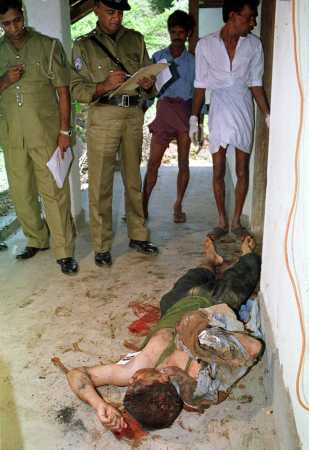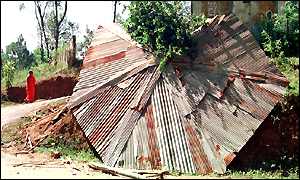| Ilankai Tamil Sangam, USA on
THE PRISON MASSACRE IN SRI LANKA |
|||||||
|
Twenty-four Tamil prisoners, mostly teenagers, were brutally murdered inside a Sri Lankan prison on 25th October 2000. Scores of other detainees were critically injured, and several are reported missing, presumably killed. Sinhala villagers, who were allowed into the prison grounds by the ‘guards’, carried out the murders. These villagers, armed with machetes, clubs and rocks, killed the defenseless detainees in the most grisly manner, and later set the prison on fire.
A clever cover-up is under way by the Sri Lanka government and its armed forces, aided and abetted by the media, both local and international. The media in Sri Lanka has always been biased, favoring the Sri Lanka government and the Sinhala people in their reporting, and the local (Sinhala) representatives of the international newswire agencies have done the same. Immediately after this massacre became known, President Chandrika Kumaratunge in an official statement said two things. Firstly, she alleged it was the “work of external forces”, reminiscent of what former president J.R. Jayawardene said about the 1983 Pogrom, where over 3,000 Tamil civilians were killed by marauding Sinhala mobs and Sinhala parliamentarians, abetted by the Sri Lankan armed forces. Unlike Jayawardene who blamed the ‘KGB’ and an unnamed ‘foreign power’, she did not specify exactly what or who these ‘external forces’ were in this instance. The President then promised a ‘speedy enquiry’ into this massacre. It is worth remembering that, on 12 December 1997, three Tamil political prisoners were similarly massacred inside the Kalutara prison, and the President at that time said, “Immediate action will be taken to initiate disciplinary charges against prison security authorities who failed to quell the rioting.” To date no enquiry, apart from a routine magisterial inquest, was ever held; no one was ever indicted, prosecuted, disciplined or penalized.
It is also worth recalling the June 1983 massacre of 52 Tamil political prisoners at the country’s prime maximum-security prison. One of those killed was a Tamil member of the Sri Lankan parliament, Selvarajah Yogachandran, whose eyes were gouged out and testicles wrenched. President Jayawardene in that instance was more frank. When asked by an Indian journalist (Kuldip Nayar) if an enquiry would be held, he retorted, “Did the British appoint a commission during the war?” [Island; 17 Feb 1985]. In this instance, the media, both local and international, have been at pains to somehow shift the blame on the Tamils. The Madras Hindu (A Tamil Nadu based Newspaper,) caption read, “20 killed in attack on LTTE camp” (October 26, 2000) to create an impression that it was an LTTE ‘military’ camp that was attacked, when in fact it knew fully well that it was a Sri Lankan prison camp for children, who the government claims are ‘former LTTE cadre.’ Local (Sinhala) agents of the three newswire services filed reports of ‘prison riots’ and stories of ‘inmates holding hostages’, etc., as what ignited the incident, when in fact it was known that there was no such unrest. President herself, in her official statement, had said, “At no time there were any incidents among the detainees and the management… There were no incidents with the neighbours either.” [AFP; 25 October]. The state run radio also indulged in this rumor mongering, in spite of the President’s statement. The state radio reported, “the inmates had tried to take over the facility on Tuesday, triggering tension…” Unnamed police and military sources were quoted to buttress this story. “Police sources said it seemed the inmates clashed with their minders…” said AFP [25 October]. The AFP also floated a story that the inmates had harassed the local villagers. In a later report that day [25 October], the AFP said, “There are reports that the inmates had been provoking the local residents in the past few days". The media reports also weaved in the much-disputed blather about the “LTTE child soldiers.” The Sri Lanka government and its supportive media have been, for some time, at pains to capitalize on the international concern for children caught in wars, by accusing the LTTE of using child soldiers, although they have never been able to prove this claim. This was a god-sent opportunity to reiterate this fib. Namini Wijedasa of the Associated Press was the first. Describing this detention camp in glowing terms, he wrote, “After surrender to the army or capture, the former child soldiers spend a year in the government center getting psychological counseling…” The opening was well utilized by Dayan Candappa of Reuters and Amal Jayasinghe of AFP, who joined in with their own versions of the ‘child soldier’ story. Faced with swift condemnation from around the world the police rounded up about 200 of the murderers, but soon released all of them ‘to prevent further communal violence’ according to the BBC. This is no different from all of the past occasions where the Sinhala civilians attacked and killed Tamils – be it in 1956, 1958, 1961, 1977-79, or 1983. No Sinhalese has ever been indicted, prosecuted or incarcerated for these murders. Why would it be different now? The pattern of cover-ups and impunity for those who participate in the genocide of Tamils is well established in Sri Lanka. All kinds of ruses and tactics are used – Delays, Information Blockade, Blatant Censorship, Barefaced Lies, etc., are all used. Numerous examples abound, but one is worth recap. The London Guardian [8 August 1983] reported the following about President Jayawardene’s attempt at a cover-up. “President Jayawardene of Sri Lanka claimed yesterday that his army withheld information from him on massacres that had been committed in the northern region of Jaffna... Leading members of the Tamil community in Jaffna have told the Guardian that in one incident, troops killed number of students waiting at a bus stop. They allege that the students, aged between 18 and 20 had been lined up separately and fired upon… Shortly afterwards troops drove through a village… shooting at random at passers by. It was claimed that troops were then ordered back to barracks. But soldiers in civilian clothes were out in jeeps and raided a number of houses, shooting inhabitants… Lawyers in Jaffna claimed that the town’s magistrate was ordered by the Ministry of Defence in Colombo not to hold a planned inquest... Asked yesterday, why no inquests had been held... President Jayawardene said: ‘I didn’t know until a couple of days ago. It is too late now.’ [London Guardian, 8th August 1983] Nothing has changed in Sri Lanka for the Tamils and nothing will, until the Tamils find their own space in a free Thamileelam.
|
|||||||
|
[Sangam Research; 27 October 2000] |
|||||||

